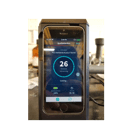Daniel Pyrek. Environmental Engineering
Title: Cayuga Lakes Harmful Algal Bloom problem: Rapid field monitoring toolkit
Mentor: Professor Ruth Richardson, Civil and Environmental Engineering
Abstract:
 Inland surface waters are experiencing more frequent and toxic cyanobacterial Harmful Algal Blooms (HABs). The microcystin toxin primarily targets the liver, but it is also a skin, eye and throat irritant. Several dogs died last year in Austin, TX (my hometown) due to HABs. Algal blooms are easy to identify visually (e.g. the “spilled green paint” appearance), but not all blooms are toxic. Traditional testing methods rely on a limited number of certified facilities, can take a long time to process (greater than 1 day), and can cost $150-$200 per sample. There is a need to develop a quicker and cheaper test that can be performed in the field by common citizens without formal scientific training.
Inland surface waters are experiencing more frequent and toxic cyanobacterial Harmful Algal Blooms (HABs). The microcystin toxin primarily targets the liver, but it is also a skin, eye and throat irritant. Several dogs died last year in Austin, TX (my hometown) due to HABs. Algal blooms are easy to identify visually (e.g. the “spilled green paint” appearance), but not all blooms are toxic. Traditional testing methods rely on a limited number of certified facilities, can take a long time to process (greater than 1 day), and can cost $150-$200 per sample. There is a need to develop a quicker and cheaper test that can be performed in the field by common citizens without formal scientific training.
 This study tested a procedure involving the Biomeme handheld qPCR device as an early warning system for oncoming blooms that could help alleviate some of the economic impact and public health risks associated with HABs contact. The correlation between mcyA gene concentration using a handheld DNA based qPCR device versus microcystin toxin concentrations obtained by standard procedure from the Community Science Institute (CSI) Ithaca was investigated. The method developed in this project can be conducted completely in the field, takes about an hour to complete, and costs less than half of the price per sample as traditional methods. This method proved effective for quickly measuring mycA concentrations in lake samples. However, this experiment could not yet prove a correlation between mycA gene concentration and microcystin toxin levels. Further analysis could be done to refine the results for samples below detection, adjust for significant changes in the ct-values of the internal positive control across all samples, explore RNA, and using the new Biomeme Franklin device.
This study tested a procedure involving the Biomeme handheld qPCR device as an early warning system for oncoming blooms that could help alleviate some of the economic impact and public health risks associated with HABs contact. The correlation between mcyA gene concentration using a handheld DNA based qPCR device versus microcystin toxin concentrations obtained by standard procedure from the Community Science Institute (CSI) Ithaca was investigated. The method developed in this project can be conducted completely in the field, takes about an hour to complete, and costs less than half of the price per sample as traditional methods. This method proved effective for quickly measuring mycA concentrations in lake samples. However, this experiment could not yet prove a correlation between mycA gene concentration and microcystin toxin levels. Further analysis could be done to refine the results for samples below detection, adjust for significant changes in the ct-values of the internal positive control across all samples, explore RNA, and using the new Biomeme Franklin device.